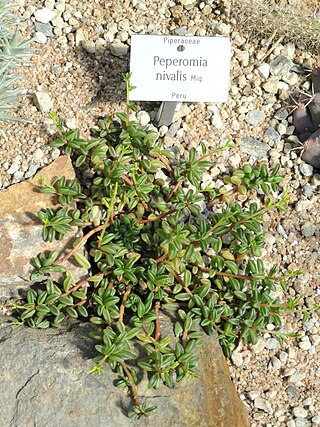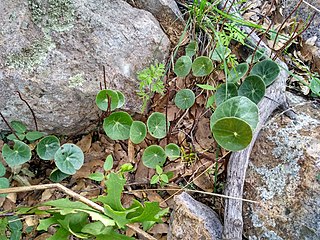
Peperomia is one of the two large genera of the family Piperaceae. It is estimated that there are at least over 1,000 species, occurring in all tropical and subtropical regions of the world. They are concentrated in South and Central America, but may also be found in southern North America, the Caribbean islands, Africa, Oceania, and southern and eastern parts of Asia. The exact number of species is difficult to determine, as some plants have been recorded several times with different names, and new species continue to be discovered. Peperomias have adapted to many different environments and their appearances vary greatly. Some are epiphytes or lithophytes, and many are xerophytes or possess underground tubers (geophytes). Most species are compact perennial shrubs or vines.
Peperomia litana is a species of plant in the family Piperaceae. It is endemic to Ecuador. It is a fairly small, glabrous herb with alternating subovate-elliptic leaves measuring approximately 1,5 by 2,5 cm. Resembles Peperomia vallensis and Peperomia suratana but differs from these by the shape of the leaves.

Peperomia nivalis is a species of plant in the genus Peperomia endemic to Peru. Its native habitat is found in the high altitude ranges of the peruvian Andes. P. nivalis is a compact erect succulent herb with fleshy stems and leaves. The thick leaves are cuneate and U-shaped in cross-section with epidermal windows on the top-side. The leaf color is bright green in the shady summer and reddish during dry sunny seasons.

Peperomia tetraphylla, known as the acorn peperomia or four-leaved peperomia, is a small plant in the Peperomia genus and the Piperaceae family that grows natively in tropical and subtropical regions around the world. Additionally in can found on Easter Island as an introduced species.

Peperomia serpens, the vining peperomia, is a species of flowering plant in the genus Peperomia and family Piperaceae, native to the New World Tropics. The plant is perennial.

Peperomia ferreyrae is a species of plant in the genus Peperomia native to Peru. It is a small, succulent herb, growing erect to about 20 cm in height. The alternating, typically 3 to 5 cm long leaves, are in the form of tubes resembling green bean pods: U-shaped in cross-section with epidermal windows on the top-side.

Peperomia nitida is a species of plant in the genus Peperomia. Its native range is in South America from Brazil to northern Argentina. It can be kept as a houseplant and is sometimes sold as cupid peperomia, or problematically as Peperomia scandens or Peperomia serpens.
Peperomia macrorhiza is a species of plant in the genus Peperomia. It is endemic to Peru. It is a geophytic plant, storing water and reserves in an underground tuber. During dry periods parts above ground, such as leaves, will wither away but the plant will survive due to the tuber. When more rain falls the plant regrows its stalks and leaves on the surface.
Peperomia peruviana is a species of flowering plant in the genus Peperomia. Its native range is in South America from Colombia to northern Argentina.
Peperomia umbilicata is a species of plant in the genus Peperomia. It is endemic to Peru. It is a geophytic plant, storing water and reserves in an underground tuber. During dry periods parts above ground, such as leaves, will wither away but the plant will survive due to the tuber. When more rain falls the plant regrows its stalks and leaves on the surface.

Peperomia bracteata is a species of plant in the genus Peperomia. Its native range covers Mexico and Guatemala. It is a geophytic plant, storing water and reserves in an underground tuber. During dry periods parts above ground, such as leaves, will wither away but the plant will survive due to the tuber. When more rain falls the plant regrows its stalks and leaves on the surface.

Peperomia monticola is a species of plant in the genus Peperomia. It's endemic to Mexico. It is a geophytic plant, storing water and reserves in an underground tuber. During dry periods parts above ground, such as leaves, will wither away but the plant will survive due to the tuber. When more rain falls the plant regrows its stalks and leaves on the surface.

Peperomia cookiana, is a species of plant in the genus Peperomia. It is endemic to Hawaiian Islands.
Peperomia zipaquirana is a herbal plant from the genus Peperomia. It was described by William Trelease and Truman G. Yuncker in 1917. It is native to Colombia and Ecuador. It is found at an elevation of 2700 – 2900 meters in Colombia.
Peperomia zarzalana is a herb species of plant from the genus Peperomia. It was described by William Trelease and Truman G. Yuncker in 1922. In Colombia, its elevation range is about 680-1100 Meters.
Peperomia yanacachiana is a species of plant in the family Piperaceae. It was discovered by Truman G. Yuncker in 1955. He discovered the plant in La Paz, Bolivia. It grows at an elevation of 2,100 metres (6,900 ft).
Peperomia variilimba is a species of perennial herb and epiphyte from the genus 'Peperomia'. It grows in wet tropical biomes. It was discovered by Guido Mathieu in 2020. the concept of Peperomia variilimba has been confusing for almost a century due to an inaccurate description of its leaf position.
Peperomia vazquezii is a species of perennial and lithophyte from the genus 'Peperomia'. It grows in wet tropical biomes. It was discovered by Guido Mathieu and Daniela Vergara-Rodríguez in 2010.
Peperomia umbrosa is a species of epiphyte from the genus Peperomia. It was first described by Guido Mathieu and published in the book "Plant Ecology and Evolution 144(2): 172. 2011.". It primarily grows on wet tropical biomes. It is endemic to Peru.








